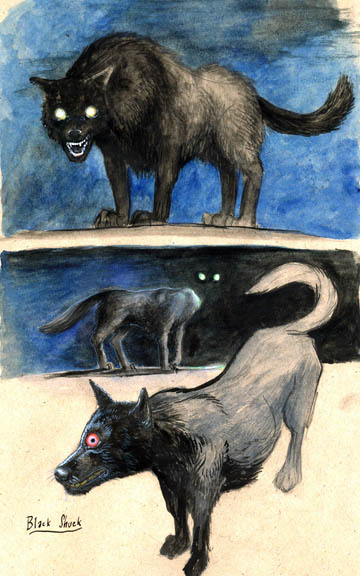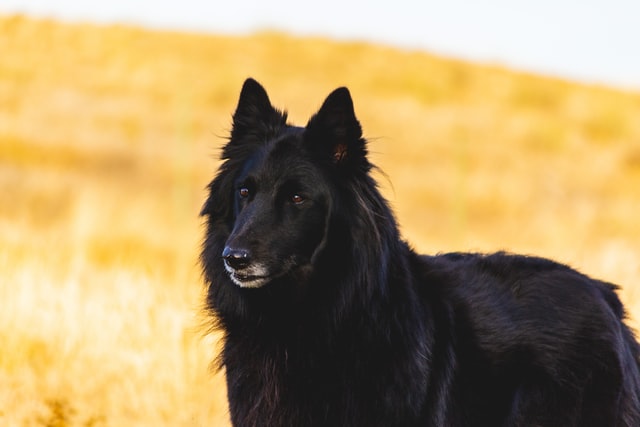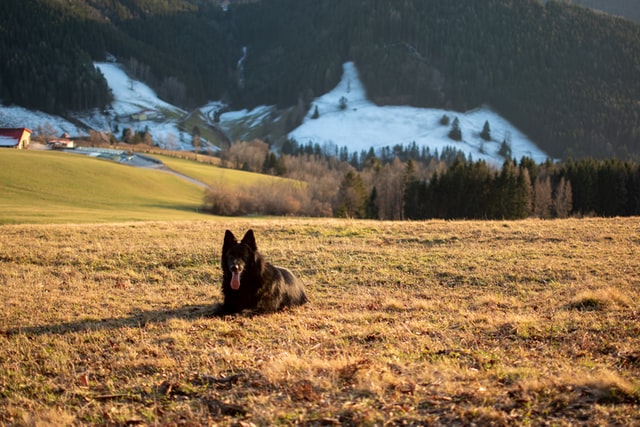One of the most pervasive figures from English folklore is that of the spectral black dog. In some parts of the country, the dogs act as death omens. Elsewhere, they represent the Devil. And in other legends, they’re even protective of travellers. Plenty for us to dig our teeth into then!
Traditionally, the black dog walks alone. It favours graveyards, lonely roads, and river banks. Emerging at dusk, its red eyes glow in the gloom. They vary in size across the tales, ranging from the size of a calf to that of a horse.

Black dogs are sometimes known as Black Shuck, shuck coming from the word ‘scucca’, an Anglo-Saxon word for ‘demon’ (Reader’s Digest 1973: 229). How very appropriate, given their most common association. Not all black dogs are Black Shuck, but they’re still worthy of study in their own right.
Let’s go in search of the Black Dog!
Black Dogs and the Devil
Many associated with black dog ghosts with the Devil until the late nineteenth century. These demonic spirits might plague homeowners, as one did in Oxfordshire between 1591 and 1592 (Davies 2007: 35). Others claimed to see the Devil in the form of a black dog. I’m not sure how they knew it was the Devil, but there you go.
Owen Davies also notes the tales of a black dog near Tring in Hertfordshire. The spirit appeared near the spot where Thomas Colley was hanged in 1751 (2007: 53). He apparently played a role in the death of Ruth Osborne, a suspected witch, taking us back to the diabolical link.

Davies highlights a new link between spectral black dogs and the human dead by the late nineteenth century. He notes the “[s]tories of ghostly dogs haunting the spots where their deceased masters or mistresses had last been seen or murdered” (2007: 36). The stories neutered the spectral black dogs, removing the demonic and giving them the same romantic qualities as human ghosts.
Black Dogs and the Barguest
In some areas, people refer to the black dogs as the Barguest or Padfoot. People debate whether these are actual black dogs or ‘bogey beasts’.
Jacqueline Simpson and Jennifer Westwood do point out that you can tell the difference between bogey beasts and black dogs through shapeshifting. True black dogs don’t take any other form, whereas some tales of the Barguest note the varying forms it takes, which include a black dog (2006: 561). They’re still worth looking at since their descriptions can bear a strong resemblance to tales of black dogs.

Padfoot
William Henderson discusses the Padfoot, a type of black dog from Yorkshire. This creature “is described as about the size of a small donkey, black, with shaggy hair and large eyes like saucers; and he follows people by night, or waylays them in the road which they have to pass” (1879: 273).
According to Henderson, the Reverend Atkinson considered the Padfoot to be a death omen. Both visible and invisible depending on the visitation, the Padfoot would walk behind, before, or beside a person, “uttering a roar totally unlike the voice of any known animal. Sometimes the trail of a chain would be heard, accompanying the light quick pad of the feet” (1879: 274). The Padfoot was apparently bigger than a sheep and had long hair. If you spoke to it or tried to strike it, you gave it power over you.
Henderson does note that the Padfoot also appears as a white dog in Horbury. It had eyes as big as saucers, and the sight of it apparently frightened one man to death (1879: 274).

The Barguest
Meanwhile, Northumberland, Yorkshire, and Durham also had the Barguest, also known as a Bahrgeist. Henderson notes this black dog was also considered a death omen, and that one of the translations of its name was that of “spirit of the bier” (1879: 275). The Barguest was also capable of taking other forms, such as “a headless man (who disappears in flame), a headless lady, a white cat, rabbit, or dog, or a black dog” (1879: 275).
Henderson goes on to discuss a specific Barguest from the area between Wreghorn and Headingly Hill near Leeds. This one took the form of “a large black dog with flaming eyes as big as saucers” and it would appear whenever a person of importance dies in the neighbourhood (1879: 275). When it did appear, other dogs in the area would follow it, barking and howling. It was important not to interfere or get in the way because “the Barguest would strike out with its paw and inflict on man or beast a wound which would never heal” (1879: 275). Henderson apparently collected this piece of lore from a gentleman who remembered seeing such a spectral procession as a child when a local squire died.
Other Regional Black Dogs
The oldest description we have of demonic black dogs dates to 1127. Strangely, this description from Peterborough sees the dogs accompany a wild hunt, where the huntsmen, horses and dogs alike were jet black (McEwan 1986: 122). Rarely do the stories elsewhere feature more than one black dog.
In Suffolk tales, the black dog sometimes appears as a harmless figure. He guards gold at Stowmarket’s Clopton Hall. This version features the body of a monk and the head of a hound. Maybe he’s terrifying enough to behold that he can live with being harmless! Many only realise they’re in the presence of the Suffolk black dog when they feel him pass by.
Though the Suffolk black dogs aren’t always friendly. On August 4, 1577, a black dog burst into St Mary’s Church in Bungay, Suffolk. Apparently, he ran down the nave, wringing the necks of two parishioners at prayer (Reader’s Digest 1973: 229).

On the same day, Black Shuck pulled the same trick at Holy Trinity Church in Blythburgh. Here, he killed a man and boy, caused the steeple to collapse, and left scorch marks on the door.
Dr David Waldron and Christopher Reeve examined the evidence from contemporary accounts (2010). They think an electrical storm on the same day caused much of the damage. The story got twisted as it passed into legend.
The Cambridgeshire black dog has more in common with the Norfolk Shuck. Stories claim that seeing him warns of a death in your family. By comparison, the Essex black dog patrols lonely roads, kindly protecting travellers. He haunts graveyards and the site of the gallows.
In Birstall, Leicestershire, the sighting of a black dog with fiery eyes was a sign of impending disaster (Westwood 2006: 415). Yet the black dog, here described as a black mastiff, could also provide protection to those in need. In one story, a girl was walking along Black Lane to get back to Birstall. She heard footsteps behind her, belonging to a bargee intent on attacking her. Out of nowhere, a dog unleashes a deep bark and runs down the slope towards her from the pit known as Shag-dog Pit. His eyes apparently glowed with spectral light. The man’s footsteps suddenly stopped but the dog padded along behind her. The next morning, the news broke that the man had gone missing (Westwood 2006: 416).
Not enough details are given to let us ascertain whether this did actually happen, but other, similar encounters are given in different parts of the country which see a black dog accompany a woman home at night in some lonely location.
Black Dogs in Norfolk
The Norfolk Shuck more closely resembles werewolves. People report hearing his howls even above high winds. Motorists swerve to avoid him when he saunters across the road. According to Reader’s Digest, “no one can set eyes on Black Shuck and live” (1973: 229), though presumably, people do to pass on their tales.
According to W.A. Dutt, “to meet him is to be warned that your death will occur before the end of the year” (1901: 216). Dutt goes on to link these black dogs with an old Viking story about Odin’s black hound. Which makes a nice change from demons. Dutt also notes Black Shuck’s fondness for storms. It seems he enjoys “the roaring of the waves” and the fact he “loves to raise his awful voice above the howling of the gale” (1901: 216).
Speaking of ghostly dogs that like the sea, one legend related by G.M. Dixon describes a shipwreck in 1709. The ‘Ever Hopeful’ (ironic, I know) ran aground near Salthouse. The captain and his pet wolfhound attempted to swim to shore but were dragged under by the current. Their bodies washed up on the beach, still clinging to one another. The locals buried the wolfhound on the beach, and the captain ended up in an unmarked grave at Salthouse Church.
Soon after, they saw a spectral black dog howling and running between Salthouse and Cley. They assumed the black dog must be none other but the wolfhound. Now with fearsome red eyes, legends abound that “a story has never been told of a man who has escaped the jaws of Black Shuck” (Dixon 1980: 27). Has time and separation from his master driven this devoted dog mad with grief?
The Hound of the Baskervilles?
I know the famous Sherlock Holmes story is set on Dartmoor. But for some, its inspiration lies in Norfolk and its Black Shuck legends. This is Cromer Hall.

Sir Arthur Conan Doyle stayed here to convalesce after contracting enteric fever in South Africa. While a guest at the hall, someone told him the legend of Black Shuck, the hell hound of Norfolk. According to this version, the dog ran through the grounds of the hall. He supposedly based Baskerville Hall on Cromer Hall when he wrote ‘The Hound of the Baskervilles’.
It was the Norfolk Shuck that inspired my short story, ‘Black Dog’. You can find it in the collection, Black Dog & Other Gothic Tales.
Exploring the Black Dog Further
There are many more tales of black dogs than I can feature here. If you’re really interested in exploring them further, then I highly recommend the book Black Dog Folklore by Mark Norman!
No one really knows if the tales refer to real giant black dogs, roaming the countryside. Or maybe they’re a trick of the light, an overactive imagination sent into overdrive by the gathering dusk.
Or perhaps they’re something else entirely…
Over to you! Have you ever seen Black Shuck? Let me know below!
References
Davies, Owen (2007), The Haunted: A Social History of Ghosts, London: Palgrave.
Dixon, G.M. (1980), Folktales and Legends of Norfolk, Peterborough: Minimax Books.
Dutt, W.A. (1901), Highways & Byways in East Anglia, London: MacMillan.
Henderson, William (1879), Notes on the folk-lore of the northern counties of England and the borders, London: W. Satchell, Peyton and Co.
McEwan, Graham J. (1986), Mystery Animals of Britain and Ireland, London: Robert Hale.
Reader’s Digest (1973), Folklore, Myths and Legends of Britain, London: Reader’s Digest Association.
Waldron, David and Christopher Reeve (2010), Shock! The Black Dog of Bungay, Harpenden: Hidden Publishing.
Westwood, Jennifer, Simpson, Jacqueline (2005), The Lore of the Land: A Guide to England’s Legends, London: Penguin.
Nutty about folklore and want more?
Add your email below and get these posts in your inbox every week.
You'll also get my 5-step guide to protecting your home using folklore!








Great post—very interesting 😉
Thank you!
loved this one i had a weird thing happend to me years ago it was lat at night an was in bed sleeping to be awoken by something i was wide awake when i saw in my ope doorway a figure of a man but was wearing a hood and long cape coat thing i couldnt see his face he was tall taller than the door frame and beside him was 2 big black dogs i mean massive half way up him near his chest they was stood on all 4 then sat at first i was scared but then suddenly i felt so calm and knew he wasnt there to hurt me i went to get out of the bed but was told to stay i did as it all lasted about about 10 mins he spoke to me but i dont remember what he said now all i know was i didnt feel scared of him or the dogs but i do know the light was blocked out of where he and the dogs stood i do remeber him telling me go back to sleep i did try i closed my eyes but couldnt i had to check my kids and brother who was staying with me at the time so i but shot out of bed checked my kids and doors and windows i was in a 3rd floor flat but still checked windows only to find all locked up like i left them kids fine all sleeping fine brother was sleeping so left them till morning then i asked him if he heard me talking last night he said yea thought i was dreaming and talking in sleep heared no one else so i always wondered who he was i couldnt see his face as it was just black inside the hood and the dogs was massive they took up a lot of room and i wasnt scared of him or them at fisrst i was because of my kids but then like i said peace came over me and i felt he wasnt there to hurt me or my kids so i just sat there and litened to what he was saying i still cant rtemember what he was saying and i no it wasnt a dream i was awake fully i could move and talk as i did shout my brother at firts thinking had break in so and the dogs i cant say what breed they was but there eyes glowed they was panting i heard that as well i wisjh i could remember what he told me it has been bugging me for years people say it was a dream and so on it wasnt i sewar it was no dream or what ever sleep thing it was real i felt the dogs breath on me hot when they was panting as they was near my bed as the room wasnt big and like i said they was big so was the cloaked person so i dont know whtat i experienced that night so mamy years ago but after that i have had other starnge things happen to me and my kids as well but i thought i would share it with you as it was about black dogs and like i said they was 2 massive black dogs
We have legends of black dogs in Scotland too. The Cu’-Sith. Same principle harbringer of death. No where near as famous as the English black dogs. My step family were from York and I hated the wee alleys in case I bumped into one lol
I’ll have to look them up – thanks!
Love this folklore of the black dog! Great article! Thank you Icy it is very interesting. ☺
Glad you liked it!
Great post! You could write a separate post for each of these stories. I’m going to share this on our Facebook page (Mysteries and Monsters), this is right up our street.
Glad to hear it – thank you for the share! I might do dramatisations of each story…
The strangest of coincidences! I just recently purchased the anthology, Protectors: Stories To Benefit PROTECT, specifically for the story, “Black Shuck” by Thomas Pluck, which I read a few good things about and just 4 pages into his story, I took a break, read my emails and saw the link to your article(!). Fascinating! + I love all the artwork and had a lot of fun with your story too! I pre-ordered the Kindle but wanted to say, please contact me if you ever come across an additional copy of Sanitarium 44. I would love to have it for my collection!
Ooh will do!
I’m sorry, but I aspire to be you. Both a witch (already on it) AND a writer?? (my desired profession, I’m a teenager so it’s not as if I have a job yet) This site is the best. Also, got a theory that Sirius actually IS a shuck. Or at least his animagus is. After all, Trelawny predicted it, and she is right SOME of the time, shucks are known to bring death, and Sirius’s appearance in the books signals the turning point to where death is featured in each book afterward, and, y’know…black dog. Shaky theory, I know, but I have to occupy my time with something! Keep up the great posts
Get yourself writing – never too early to start!
And yeah, I can see how Sirius might be a Shuck. Lord, imagine if your Patronus was a Shuck!!
https://great-castles.com/leedsghost.html the Black Dog of Leeds Castle in Kent….